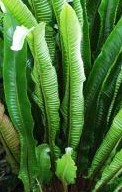 This deciduous perennial fern is a native of Europe, the Middle East, North Africa and northern parts of Asia where it grows in moist limestone-rich soils. North America hosts a tetraploid variety. Light brown scaly rhizomes give rise to clumps of tall thin medium green fronds up to twenty inches long and five inches wide. The tips are usually pointed or crested and the edges straight, undulated, or frilled, all on the same plant. The fronds are erect at first but bend with maturity. They shrivel over the winter and should be cut back before new growth appears. Spore cases appear on the lower surface of the frond in a herringbone pattern. Hart’s tongue fern was named for its resemblance to the tongue of a deer (hart). It is an excellent choice for a cool shady garden but is also a popular houseplant.
This deciduous perennial fern is a native of Europe, the Middle East, North Africa and northern parts of Asia where it grows in moist limestone-rich soils. North America hosts a tetraploid variety. Light brown scaly rhizomes give rise to clumps of tall thin medium green fronds up to twenty inches long and five inches wide. The tips are usually pointed or crested and the edges straight, undulated, or frilled, all on the same plant. The fronds are erect at first but bend with maturity. They shrivel over the winter and should be cut back before new growth appears. Spore cases appear on the lower surface of the frond in a herringbone pattern. Hart’s tongue fern was named for its resemblance to the tongue of a deer (hart). It is an excellent choice for a cool shady garden but is also a popular houseplant.
Type: Deciduous herbaceous perennial
Bloom: None
Size: 27 ‘ H x 24” W
Light: Partial to full shade (less than three hours of sun/day)
Soil: Average, evenly moist, limestone based
Hardiness: Zones 6-8
Care: Remove old leaves in winter before new growth appears; fertilize in the spring and monthly with a liquid fertilizer at half strength during the summer.
Pests and Diseases: None of significance except rust but if grown as a house plant is susceptible to root rot, greenfly, blackfly, capsids, slugs, snails, vine weevil grubs, and eel worm.
Propagation: Spores, division in spring
Companion plants: Hosta, ferns, foxglove, epilobiums, comfrey, camassias.
